美国民事诉讼中的三种禁止令
- 格式:docx
- 大小:15.10 KB
- 文档页数:2
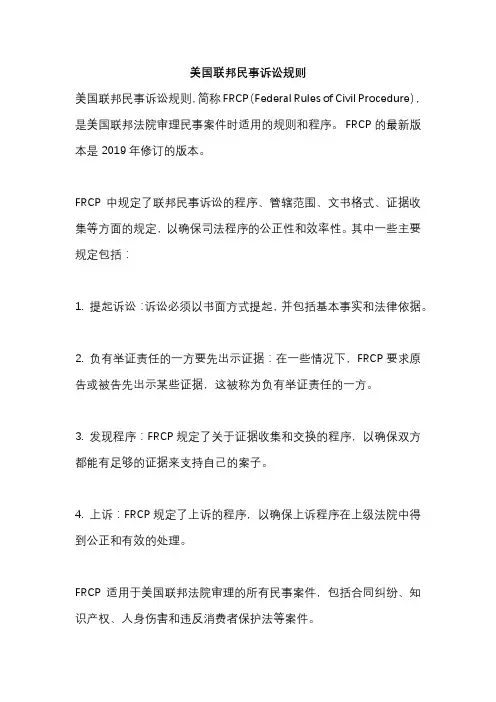
美国联邦民事诉讼规则
美国联邦民事诉讼规则,简称FRCP(Federal Rules of Civil Procedure),是美国联邦法院审理民事案件时适用的规则和程序。
FRCP的最新版本是2019年修订的版本。
FRCP中规定了联邦民事诉讼的程序、管辖范围、文书格式、证据收集等方面的规定,以确保司法程序的公正性和效率性。
其中一些主要规定包括:
1. 提起诉讼:诉讼必须以书面方式提起,并包括基本事实和法律依据。
2. 负有举证责任的一方要先出示证据:在一些情况下,FRCP要求原告或被告先出示某些证据,这被称为负有举证责任的一方。
3. 发现程序:FRCP规定了关于证据收集和交换的程序,以确保双方都能有足够的证据来支持自己的案子。
4. 上诉:FRCP规定了上诉的程序,以确保上诉程序在上级法院中得到公正和有效的处理。
FRCP适用于美国联邦法院审理的所有民事案件,包括合同纠纷、知识产权、人身伤害和违反消费者保护法等案件。
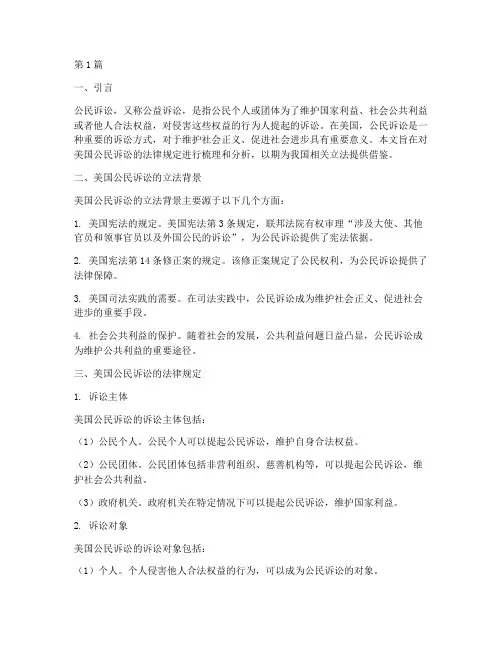
第1篇一、引言公民诉讼,又称公益诉讼,是指公民个人或团体为了维护国家利益、社会公共利益或者他人合法权益,对侵害这些权益的行为人提起的诉讼。
在美国,公民诉讼是一种重要的诉讼方式,对于维护社会正义、促进社会进步具有重要意义。
本文旨在对美国公民诉讼的法律规定进行梳理和分析,以期为我国相关立法提供借鉴。
二、美国公民诉讼的立法背景美国公民诉讼的立法背景主要源于以下几个方面:1. 美国宪法的规定。
美国宪法第3条规定,联邦法院有权审理“涉及大使、其他官员和领事官员以及外国公民的诉讼”,为公民诉讼提供了宪法依据。
2. 美国宪法第14条修正案的规定。
该修正案规定了公民权利,为公民诉讼提供了法律保障。
3. 美国司法实践的需要。
在司法实践中,公民诉讼成为维护社会正义、促进社会进步的重要手段。
4. 社会公共利益的保护。
随着社会的发展,公共利益问题日益凸显,公民诉讼成为维护公共利益的重要途径。
三、美国公民诉讼的法律规定1. 诉讼主体美国公民诉讼的诉讼主体包括:(1)公民个人。
公民个人可以提起公民诉讼,维护自身合法权益。
(2)公民团体。
公民团体包括非营利组织、慈善机构等,可以提起公民诉讼,维护社会公共利益。
(3)政府机关。
政府机关在特定情况下可以提起公民诉讼,维护国家利益。
2. 诉讼对象美国公民诉讼的诉讼对象包括:(1)个人。
个人侵害他人合法权益的行为,可以成为公民诉讼的对象。
(2)企业。
企业侵害社会公共利益的行为,可以成为公民诉讼的对象。
(3)政府机关。
政府机关侵害公民合法权益的行为,可以成为公民诉讼的对象。
3. 诉讼程序美国公民诉讼的程序主要包括以下几个阶段:(1)起诉。
公民个人或团体向法院提起诉讼,说明诉讼请求和事实依据。
(2)受理。
法院对起诉进行审查,决定是否受理。
(3)审理。
法院对案件进行审理,包括证据交换、辩论、判决等环节。
(4)执行。
法院对判决进行执行,保障诉讼请求的实现。
4. 诉讼时效美国公民诉讼的诉讼时效为3年,自知道或应当知道侵权行为之日起计算。

国际民诉中禁诉令的运用及我国禁诉令制度的构建关键词: 禁诉令平行诉讼司法命令管辖冲突内容提要: 禁诉令是解决国际平行诉讼冲突的重要手段。
对于禁诉令签发的条件,不同法院的要求并不一致,自由主义模式比较宽松,而保守主义模式则要求严格。
我国目前尚无禁诉令制度,但建立该制度有助于减少平行诉讼、保障中国法院管辖权不被侵蚀。
禁诉令的签发应慎重,只有在纠纷与中国有实质性,而在外国法院重复诉讼为不合理时,才能签发禁诉令。
“禁令”(injunction)是英美法的制度,意指法院作出的要求当事人为或者不为特定行为的命令。
禁令最早可以追溯到古罗马时代。
在罗马法中,禁令又称禁止令状(interdicere),是由罗马执政官根据受害人的请求发布的某种命令。
中世纪的寺院法中也有禁令的规定。
英美法中的禁令内容复杂,种类繁多。
禁诉令(anti—suit injunction)是禁止当事人在其他法院诉讼的命令,它最初是英国解决国内平行诉讼(parallel litigation)的手段。
在早期的英格兰,王室法院和教会法院之间存在管辖权上的重叠,王室法院常用禁诉令限制当事人在教会法院诉讼。
禁诉令也被衡平法院用于与普通法院争夺管辖权。
如果衡平法院认为由普通法院审理不合适,就可以向普通法院诉讼中的原告发出禁诉令。
这种解决国内平行诉讼的方法后被用于解决国际平行诉讼冲突,即相同当事人就同一争议同时在两个以上国家诉讼。
英格兰法院早在19世纪初期就开始以禁诉令解决国际诉讼竞合问题,通过颁发禁诉令,命令当事人不得在外国法院起诉或参加外国诉讼程序。
英国法院认为,它有权对受其管辖的当事人设定限制,这种权力叫衡平权力(equitable power),并一再使用禁诉令。
美国法院在国际民诉中使用禁诉令的案例也不在少数。
一、国际民诉中禁诉令使用的场合从英美国家禁诉令的使用情况看,法院颁发禁诉令的场合有四:1.在对抗诉讼中颁发禁诉令。
这是最常见的颁发禁诉令的场合。
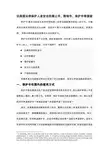
论美国法律保护人身安全的禁止令、限制令、保护令等措施保护令1是由法院签发的用来限制某人伤害或威胁要伤害他人的行为。
它被用来处理各种类型的安全问题,包括但不限于与家庭暴力有关的情况。
家庭法院、刑事法院和最高法院都可以发出保护令。
保护令可使冒犯者不去伤害、威胁或骚扰你、你的家人或者其他任何列在保护令上的人。
它可能包括,但并不局限于,使冒犯者:●远离你和你的孩子●从你家搬出●遵守监管令●支付子女抚养费●不得持有枪械如果单身女性能够证明自己受到了对方的骚扰,就可以申请法庭的限制令。
一、保护令在国外的使用方式保护令是在普通法系下由法官受理申请所签发的手令,用以保护申请人不受被限制人骚扰、暴力等行为。
在美国,保护令被视为宪法重要的一环。
那么在美国如何申请保护令?有哪些步骤?向哪里申请?如何生效?首先,如果是刑事犯罪的受害人的话,警察会为受害人申请紧急保护令,在这样的情况下,根据警察的指示,按照他们的方式完完全全的保护权利。
其次,在民事方面,如何申请保护令,应该先明确应该在哪个法院去申请保护。
如可以在洛杉矶法院网站输入住址的邮编就会知道相应的法庭来处理,来到法庭应该直1A restraining order or protective order is an order used by a court to protect a person, business, company, establishment, or entity, and the general public, in a situation involving alleged domestic violence, harassment, stalking, or sexual assault. In the United States, every state has some form of domestic violence restraining order law, and many states also have specific restraining order laws for stalking and sexual assault.接到Law’s Clerk Office(法庭助理的办公室)告诉他们需要申请保护令(Restraining Orders),在一系列的表格中填写个人信息以及对方的信息(姓名和住址),如不能提供被限制人住址也要提供其经常出入的场所,以便送达保护令。
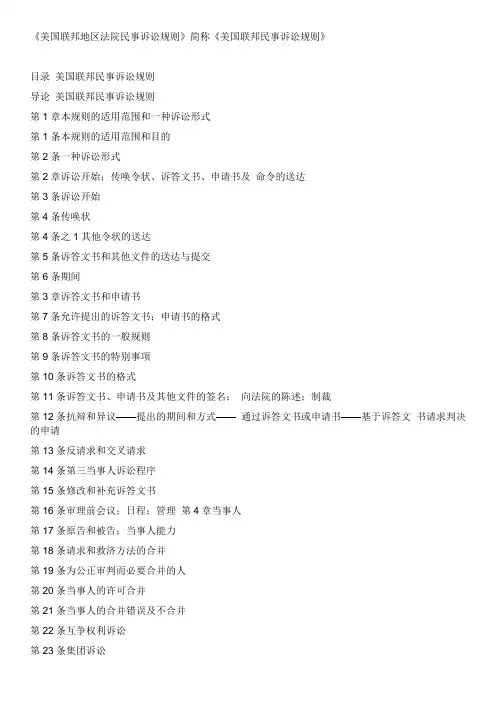
《美国联邦地区法院民事诉讼规则》简称《美国联邦民事诉讼规则》目录美国联邦民事诉讼规则导论美国联邦民事诉讼规则第1章本规则的适用范围和一种诉讼形式第1条本规则的适用范围和目的第2条一种诉讼形式第2章诉讼开始;传唤令状、诉答文书、申请书及命令的送达第3条诉讼开始第4条传唤状第4条之1其他令状的送达第5条诉答文书和其他文件的送达与提交第6条期间第3章诉答文书和申请书第7条允许提出的诉答文书;申请书的格式第8条诉答文书的一般规则第9条诉答文书的特别事项第10条诉答文书的格式第11条诉答文书、申请书及其他文件的签名;向法院的陈述;制裁第12条抗辩和异议——提出的期间和方式——通过诉答文书或申请书——基于诉答文书请求判决的申请第13条反请求和交叉请求第14条第三当事人诉讼程序第15条修改和补充诉答文书第16条审理前会议;日程;管理第4章当事人第17条原告和被告;当事人能力第18条请求和救济方法的合并第19条为公正审判而必要合并的人第20条当事人的许可合并第21条当事人的合并错误及不合并第22条互争权利诉讼第23条集团诉讼第23条之1股东的派生诉讼第23条之2关于非法人团体的诉讼第24条诉讼参加第25条替代当事人第5章庭外证言与发现程序第26条规范发现程序的一般规定;出示义务第27条诉讼之前和上诉系属期间的庭外证言第28条参与作成庭外证言的人员第29条关于发现程序的约定第30条口头询问的庭外证言第31条书面质问的庭外证言第32条在法院的诉讼程序中庭外证言的使用第33条对当事人的质问书第34条提供文件和物件以及为调查或其他目的而进入房地产第35条身体和精神状态的检查第36条要求自认第37条不出示或不协助发现:制裁第6章开庭审理第38条要求陪审团审判的权利第39条陪审团审判或法院审判第40条为开庭审理而分配案件第41条撤销诉讼第42条合并;分开审理第43条证言的取得第44条官方记录证明第44条之1外国法的确定第45条传票第46条不需要提出异议第47条选定陪审团成员第48条陪审团成员人数——参与裁决第49条特别裁决和质问书第50条在陪审团审判的案件中作为法律问题作出的判决;选择重新审理的申请;有条件的裁定第51条对陪审团的指示:异议第52条法院认定事实;部分认定事实的判决第53条主事官第7章判决第54条判决;费用第55条缺席第56条简易判决第57条宣告判决第58条登记判决第59条重新审理;判决的修改第60条对判决或命令的救济第61条无害的错误第62条执行判决程序的中止第63条法官不能继续执行职务第8章临时性和终局性财产救济方法第64条对人或财产的扣押第65条禁止令第65条之1担保:对保证人的诉讼程序第66条被联邦法院任命的财产管理人第67条向法院提存第68条判决方案要约第69条执行第70条特定行为的判决;赋予权限第71条有利于或不利于非当事人的第三人的令状第9章特别程序第71条之1不动产征收第72条补助法官;审理前命令第73条补助法官;同意审判及上诉的选择权第74条根据《美国法典》第28编第636条第3款(4)项和本规则第73条第4 款的规定,对补助法官作出的决定向地区法院法官提起上诉的方式第75条根据本规则第73条第4款的规定,对补助法官作出的决定向地区法院法官提起上诉的程序第76条根据本规则第73条第4款的规定向地区法院法官提起上诉案件的判决和诉讼费用第10章地区法院及其书记官第77条地区法院及其书记官第78条申请期日第79条书记官保管的登记簿和记录以及登记第80条速记员;用作证据的速记员报告及速记译回文字第11章一般条款第81条一般适用性第82条管辖区域及审判地不受影响第83条地区法院的规则;法官的指令第84条诉讼文书格式第85条本规则的称谓第86条生效日期附件一:诉讼文书格式附件二:《美国联邦民事诉讼规则》中的词汇英中文语义对照表美国联邦证据规则导言《美国联邦证据规则》介绍第1章一般规定第101条适用范围第102条目的和结构第103条关于证据的裁定(a)错误裁定的后果(1)异议(2)提供证明(b)关于提供证据和裁定的记录(c)陪审团审理(d)显见错误第104条初步询问(a)关于可采性的一般询问(b)以事实为条件的相关性(c)陪审团审理(d)被告人作证(e)重要性和可信性第105条有限的可采性第106条书面或录音证词的剩余部分或相关部分第2章司法认知第201条关于裁判事实的司法认知(a)适用范围(b)事实种类(c)任意采用(d)强制采用(e)被听证的机会(f)采用司法认知的时间(g)指示陪审团第3章民事诉讼中的推定第301条民事诉讼中推定的一般规定第302条民事诉讼中州法的适用性第4章相关性及其限制第401条“相关证据”的定义第402条相关证据一般可以采纳;无相关性的证据不能采纳第403条因偏见、混淆或浪费时间而排除相关证据第404条品格证据不能采纳来证明行为;例外;其他犯罪(a)品格证据的一般规定(1)被告人的品格(2)被害人的品格(3)证人的品格(b)其他犯罪、错误或行为第405条证明品格的方法(a)名声或评价(b)特定行为实例第406条习惯;日常工作第407条随后的补救措施第408条和解和要求和解第409条支付医疗或类似费用第410条答辩、答辩讨论和有关陈述不可采纳第411条责任保险第412条性犯罪案件;与被害人过去行为相关第5章特权第501条一般规则第6章证人第601条关于证人能力的一般规则第602条缺乏亲身体验第603条宣誓或郑重声明第604条译员第605条法官作为证人的能力第606条陪审员作为证人的能力(a)参加审理(b)对陪审团裁决或起诉书合法性的调查第607条谁可以提出质疑第608条关于证人品格和行为的证据(a)关于品格的评价证据和名声证据(b)行为的具体实例第609条以曾被定罪的证据提出质疑(a)一般规则(b)时间限制(c)赦免、撤销或证明恢复名誉的效果(d)未成年人的裁判(e)上诉未决第610条宗教信仰或主张第611条询问和举证的方式和次序(a)法庭控制(b)交叉询问的范围(c)诱导性问题第612条使用书面材料来唤醒记忆第613条证人先前的陈述(a)就证人先前的陈述进行询问(b)有关证人先前陈述不一致的外部证据第614条法庭传唤和询问证人(a)法庭传唤证人(b)法庭询问(c)异议第615条排除证人第7章意见证据和专家证词第701条一般证人的意见证词第702条专家证词第703条专家意见证词的基础第704条关于最终争议的意见第705条公开专家意见所依据的事实和数据第706条法庭指定专家(a)指定(b)补偿(c)将指定公开(d)当事人自己选择专家第8章传闻证据第801条定义(a)陈述(b)陈述者(c)传闻(d)不是传闻的陈述(1)证人的先前陈述(2)为对立当事人承认第802条传闻证据规则第803条传闻证据的例外;陈述者可否作证无关紧要(1)表达感觉印象(2)刺激的发泄(3)当时存在的精神、感情或身体状态(4)出于医疗诊断或治疗目的的陈述(5)被记录的回忆(6)关于日常行为、活动的记录(7)在第(6)项规定的记录中缺乏记载(8)公共记录或报告(9)重要统计资料(10)缺乏公共记录或没有记载(11)宗教组织的记录(12)婚姻、洗礼或类似证明(13)家庭记录(14)反映财产利益的文件记录(15)文件中反映财产利益的陈述(16)在陈年文件中的陈述(17)市场报告商业出版物(18)学术论文(19)关于个人或家庭历史的名声(20)关于边界和一般历史的名声(21)性格方面的名声(22)先前定罪的判决(23)关于个人、家庭、或一般历史、或边界的判决(24)其他例外第804条传闻证据的例外;陈述者不能到庭作证(a)不能出庭的定义(b)传闻证据的例外(1)先前证词(2)临终陈述(3)对己不利的陈述(4)关于个人或家史的陈述(5)其他例外第805条传闻中的传闻…第806条攻击和支持陈述者的可信性第9章鉴定和辨认第901条要求鉴定或辨认(a)一般规定(b)说明(1)具有知识的人的证明(2)对笔迹的非专家意见(3)由审判者或专家证人进行比较(4)与众不同的特征或类似品质(5)声音辨认(6)声音通话(7)公共记录或报告(8)陈年文件或数据汇编(9)过程或系统(10)法律或规则规定的方法第902条自我鉴定(1)国内盖有印章的公文(2)国内未盖印章的公文(3)外国公文(4)经证实的公共记录的副本(5)官方出版物(6)报纸和期刊(7)商品注册或类似标记(8)被承认的文件(9)商业票据和相关文件(10)根据国会立法推定第903条不必要有补强证人证词第10章文字、录音和照相的内容第1001条定义(1)文字和录音(2)照相(3)原件(4)复制品第1002条要求原件第1003条复制品的可采性第1004条其他关于内容的证据的可采性(1)原件遗失或毁坏(2)原件无法获得(3)原件在对方掌握中(4)附属事项第1005条公共记录第1006条摘要第1007条当事人的证词或书面承认第1008条法庭和陪审团的职能第11章综合规则第1101条规则的适用性(a)法院和治安法院(b)诉讼范围(c)关于特权的规则(d)不适用规则的情况(e)部分适用的规则第1102条修改第1103条标题FEDERAL RULES OF CIVIL PROCEDUREI.SCOPE OF RULES ONE FORM OF ACTIONRule1 Scope and Purpose of RulesThese rules govern the procedure in the United States district courts in all suits of a civil nature whether cognizable as cases at law or in equity or in admiralty, with the exceptions stated in Rule 81. They shall be construed and administered to secure the just, speedy, and inexpensive determination of every action.Rule 2 One Form of ActionThere shall be one form of action to be known as civil action.II. COMMENCEMENT OF ACTION; SERVICE OF PROCESS, PLEADINGS, MOTIONS, AND ORDERSRule 3 Commencement of ActionA civil action is commenced by filing a complaint with the court.Rule 4 Summons(a) Form. The summons shall be signed by the clerk, bear the seal of the court, identify the court and the parties, be directed to the defendant, and state the name and address of the plaintiff's attorney or, if unrepresented, of the plaintiff. It shall also state the time within which the defendant must appear and defend, and notify the defendant that failure to do so will result in a judgment by default against the defendant for the relief demanded in the complaint. The court may allow a summons to be amended.(b) Issuance. Upon or after filing the complaint, the plaintiff may present a summons to the clerk for signature and seal. If the summons is in proper form, the clerk shall sign, seal, and issue it to the plaintiff for service on the defendant. A summons, or a copy of the summons if addressed to multiple defendants, shall be issued for each defendant to be served.(c) Service with Complaint; by Whom Made.(1) A summons shall be served together with a copy of the complaint. The plaintiff isresponsible for service of a summons and complaint within the time allowed under subdivision(m) and shall furnish the person effecting service with the necessary copies of the summonsand complaint.(2) Service may be effected by any person who is not a party and who is at least 18 years of age. At the request of the plaintiff, however, the court may direct that service be effected by a United States marshal, deputy United States marshal, or other person or officer specially appointed by the court for the purpose. Such an appointment must be made when the plaintiff is authorized to proceed in forma pauperis pursuant to28 U.S.C. §1915 or is authorized to proceed as a seaman under 28 U.S.C. §1916(d) Waiver of Service; Duty to Save Costs of Service; Request to Waive.(1) A defendant who waives service of a summons does not thereby waive any objection to the venue or to the jurisdiction of the court over the person of the defendant.(2) An individual, corporation, or association that is subject to service under subdivision(e), (f), or (h) and that receives notice of an action in the manner provided in this paragraph has a duty to avoid unnecessary costs of serving the summons. To avoid costs, the plaintiff may notify such a defendant of the commencement of the action and request that the defendant waive service of a summons. The notice and request.(A) shall be in writing and shall be addressed directly to the defendant,if an individual, or else to an officer or managing or general agent (or otheragent authorized by appointment or law to receive service of process) of adefendant subject to service under subdivision (h) ;(B) shall be dispatched through first-class mail or other reliable means;(C) shall be accompanied by a copy of the complaint and shall identify thecourt in which it has been filed;(D) shall inform the defendant, by means of a text prescribed in an officialform promulgated pursuant to Rule 84, of the consequences of compliance andof a failure to comply with the request;(E) shall set forth the date on which request is sent; (F) shall allow thedefendant a reasonable time to return the waiver, which shall be at least30 days from the date on which the request is sent, or 60 days from that dateif the defendant is addressed outside any judicial district of the UnitedStates; and(G) shall provide the defendant with an extra copy of the notice and request,as well as a prepaid means of compliance in writing.If a defendant located within the United States fails to comply with a requestfor waiver made by a plaintiff located within the United States, the courtshall impose the costs subsequently incurred in effecting service on thedefendant unless good cause for the failure be shown.(3) A defendant that, before being served with process, timely returns a waiver so requested is not required to serve an answer to the complaint until 60 days after the date on which the request for waiver of service was sent, or 90 days after that date if the defendant was addressed outside any judicial district of the United States.(4) When the plaintiff files a waiver of service with the court, the action shall proceed, except as provided in paragraph (3), as if a summons and complaint had been served at the time of filing the waiver, and no proofs of service shall be required.(5) The costs to be imposed on a defendant under paragraph (2) for failure to comply witha request to waive service of a summons shall include the costs subsequently incurred in effecting service under subdivision (e), (f), or (h), together with the costs, including a reasonable attorney's fee, of any motion required to collect the costs of service.(e) Service Upon Individuals Within a Judicial District of the United States. Unless otherwise provided by federal law, service upon an individual from whom a waiver has not been obtained and filed, other than an infant or an incompetent person, may be effected in any judicial district of the United States:(1) pursuant to the law of the state in which the district court is located, or in whichservice is effected, for the service of a summons upon the defendant in an action broughtin the courts of general jurisdiction of the State; or(2) by delivering a copy of the summons and of the complaint to the individual personallyor by leaving copies thereof at the individual's dwelling house or usual place of abodewith some person of suitable age and discretion then residing therein or by deliveringa copy of the summons and of the complaint to an agent authorized by appointment or bylaw to receive service of process.(f) Service Upon Individuals in a Foreign Country. Unless otherwise provided by federal law, service upon an individual from whom a waiver has not been obtained and filed, other than an infant or an incompetent person, may be effected in a place not within any judicial district of the United States:(1) by any internationally agreed means reasonably calculated to give notice, such as thosemeans authorized by the Hague Convention on the Service Abroad of Judicial and ExtrajudicialDocuments; or(2) if there is no internationally agreed means of service or the applicable internationalagreement allows other means of service, provided that service is reasonably calculatedto give notice:(A) in the manner prescribed by the law of the foreign country for servicein that country in an action in any of its courts of general jurisdiction;or(B) as directed by the foreign authority in response to a letter rogatoryor letter of request; or(C) unless prohibited by the law of the foreign country, by(i) delivery to the individual personally of a copy of thesummons and the complaint; or(ii) any form of mail requiring a signed receipt, to beaddressed and dispatched by the clerk of the court to the partyto be served; or(3) by other means not prohibited by international agreement as may be directed by thecourt.(g) Service Upon Infants and Incompetent Person. Service upon an infant or an incompetent person in a judicial district of the United States shall be effected in the manner prescribed by the law of the state in which the service is made for the service of summons or like process upon any such defendant in an action brought in the courts of general jurisdiction of that state. Service upon an infant or an incompetentperson in a place not within any judicial district of the United States shall be effected in the manner prescribed by paragraph (2)(A) or (2)(B) of subdivision (f) or by such means as the court may direct.(h) Service Upon Corporations and Associations. Unless otherwise provided by federal law, service upon a domestic or foreign corporation or upon a partnership or other unincorporated association that is subject to suit under a common name, and from which a waiver of service has not been obtained and filed, shall be effected:(1) in a judicial district of the United States in the manner prescribed for individualsby subdivision (e)(1), or by delivering a copy of the summons and of the complaint to anofficer, a managing or general agent, or to any other agent authorized by appointment orby law to receive service of process and, if the agent is one authorized by statute toreceive service and the statute so requires, by also mailing a copy to the defendant, or(2) in a place not within any judicial district of the United States in any manner prescribedfor individuals by subdivision (f) except personal delivery as provided in paragraph(2)(C)(i) thereof.(i) Serving the United States, Its Agencies, Corporations, Officers, or Employees.(1) Service upon the United States shall be effected(A) by delivering a copy of the summons and of the complaint to the UnitedStates attorney for the district in which the action is brought or to anassistant United States attorney or clerical employee designated by theUnited States attorney in a writing filed with the clerk of the court or bysending a copy of the summons and of the complaint by registered or certifiedmail addressed to the civil process clerk at the office of the United Statesattorney and(B) by also sending a copy of the summons and of the complaint by registeredor certified mail to the Attorney General of the United States at Washington,District of Columbia, and(C) in any action attacking the validity of an order of an officer or agencyof the United States not made a party, by also sending a copy of the summonsand of the complaint by registered or certified mail to the officer or agency.(2)(A) Service on an agency or corporation of the United States, or an officer or employeeof the United States sued only in an official capacity, is effected by serving the UnitedStates in the manner prescribed by Rule 4 (i)(1) and by also sending a copy of the summonsand complaint by registered or certified mail to the officer, employee, agency, orcorporation.(B) Service on an officer or employee of the United States sued in anindividual capacity for acts or omissions occurring in connection with theperformance of duties on behalf of the United States whether or not theofficer or employee is sued also in an official capacity is effected byserving the United States in the manner prescribed by Rule 4 (i)(1) and byserving the officer or employee in the manner prescribed by Rule 4 (e), (f),or (g).(3) The court shall allow a reasonable time to serve process under Rule 4 (i) for the purposeof curing the failure to serve:(A) all persons required to be served in an action governed by Rule 4 (i)(2)(A),if the plaintiff has served either the United States attorney or the AttorneyGeneral of the United States, or(B) the United States in an action governed by Rule 4 (i)(2)(B), if theplaintiff has served an officer or employee of the United States sued in anindividual capacity.(j) Service Upon Foreign, State, or Local Governments.(1) Service upon a foreign state or a political subdivision, agency, or instrumentalitythereof shall be effected pursuant to 28 U.S.C. §1608(2) Service upon a state, municipal corporation, or other governmental organization subjectto suit, shall be effected by delivering a copy of the summons and of the complaint toits chief executive officer or by serving the summons and complaint in the manner prescribedby the law of that state for the service of summons or other like process upon any suchdefendant.(k) Territorial Limits of Effective Service.(1) Service of a summons or filing a waiver of service is effective to establish jurisdictionover the person of a defendant(A) who could be subjected to the jurisdiction of a court of generaljurisdiction in the state in which the district court is located, or(B) who is a party joined under Rule 14 or Rule 19 and is served at a placewithin a judicial district of the United States and not more than 100 milesfrom the place from which the summons issues, or(C) who is subject to the federal interpleader jurisdiction under 28 U.S.C.§ 1335, or(D) when authorized by a statute of the United States.(2) If the exercise of jurisdiction is consistent with the Constitution and laws of theUnited States, serving a summons or filing a waiver of service is also effective, withrespect to claims arising under federal law, to establish personal jurisdiction over theperson of any defendant who is not subject to the jurisdiction of the courts of generaljurisdiction of any state.(l) Proof of Service. If service is not waived, the person effecting service shall make proof thereof to the court. If service is made by a person other than a United States marshal or deputy United Statesmarshal, the person shall make affidavit thereof. Proof of service in a place not within any judicial district of the United States shall, if effected under paragraph (1) of subdivision (f), be made pursuant to the applicable treaty or convention, and shall, if effected under paragraph (2) or (3) thereof, include a receipt signed by the addressee or other evidence of delivery to the addressee satisfactory to the court. Failure to make proof of service does not affect the validity of the service. The court may allow proof of service to be amended.(m) Time Limit for Service. If service of the summons and complaint is not made upon a defendant within 120 days after the filing of the complaint, the court, upon motion or on its own initiative after notice to the plaintiff, shall dismiss the action without prejudice as to that defendant or direct that service be effected within a specified time; provided that if the plaintiff shows good cause for the failure, the court shall extend the time for service for an appropriate period. This subdivision does not apply to service in a foreign country pursuant to subdivision (f) or (j)(1).(n) Seizure of Property; Service of Summons Not Feasible.(1) If a statute of the United States so provides, the court may assert jurisdiction overproperty. Notice to claimants of the property shall than be sent in the manner providedby the statute or by service of a summons under this rule.(2) Upon a showing that personal jurisdiction over a defendant cannot, in the districtwhere the action is brought, be obtained with reasonable efforts by service of summonsin any manner authorized by this rule, the court may assert jurisdiction over any of thedefendant's assets found within the district by seizing the assets under the circumstancesand in the manner provided by the law of the state in which the district court is located.Rule 4.1. Service of Other Process(a) Generally. Process other than a summons as provided in Rule 4 or subpoena as provided in Rule 45 shall be served by a United States marshal, a deputy United States marshal, or a person specially appointed for that purpose, who shall make proof of service as provided in Rule 4 (1). The process may be served anywhere within the territorial limits of the state in which the district court is located, and, when authorized by a statute of the United States, beyond the territorial limits of that state.(b) Enforcement of Orders: Commitment for Civil Contempt. An order of civil commitment of a person held to be in contempt of a decree or injunction issued to enforce the laws of the United States may be served and enforced in any district. Other orders in civil contempt proceedings shall be served in the state in which the court issuing the order to be enforced is located or elsewhere within the United States if not more than 100 miles from the place at which the order to be enforced was issued.Rule 5 Service and Filing of Pleadings and Other Papers(a) Service: When Required. Except as otherwise provided in these rules, every order required by its terms to be served, every pleading subsequent to the original complaint unless the court otherwise orders because of numerous defendants, every paper relating to discovery required to be served upon a party unless the court otherwise orders, every written motion other than one which may be heard ex parte, and every written notice, appearance, demand, offer of judgment, designation of record on appeal, and similar paper shall be served upon each of the parties. No service need be made on parties in default for failure to appear except that pleadings asserting new or additional claims for relief against them shall be served upon them in the manner provided for service of summons in Rule 4.In an action begun by seizure of property, in which no person need be or is named as defendant, any service required to be made prior to the filing of an answer, claim, or appearance shall be made upon the person having custody or possession of the property at the time of its seizure.(b) Same: How Made. Whenever under these rules service is required or permitted to be made upon a party represented by an attorney the service shall be made upon the attorney unless service upon the party is ordered by the court. Service upon the attorney or upon a party shall be made by delivering a copy to the attorney or party or by mailing it to the attorney or party at the attorney's or party's last known address or, if no address is known, by leaving it with the clerk of the court. Delivery of a copy within this rule means: handing it to the attorney or to the party; or leaving it at the attorney's or party's office with a clerk or other person in charge thereof; or, if there is no one in charge, leaving it in a conspicuous place therein; or, if the office is closed or the person to be served has no office, leaving it at the person's dwelling house or usual place of abode with some person of suitable age and discretion then residing therein. Service by mail is complete upon mailing.(c) Same: Numerous Defendants. In any action in which there are unusually large numbers of defendants, the court, upon motion or of its own initiative, may order that service of the pleadings of the defendants and replies thereto need not be made as between the defendants and that any cross-claim, counterclaim, or matter constituting an avoidance or affirmative defense contained therein shall be deemed to be denied or avoided by all other parties and that the filing of any such pleading and service thereof upon the plaintiff constitutes due notice of it to the parties. A copy of every such order shall be served upon the parties in such manner and form as the court directs.(d) Filing; Certificate of Service. All papers after the complaint required to be served upon a party, together with a certificate of service, must be filed with the court within a reasonable time after service, but disclosures under Rule 26 (a)(1) or (2) and the following discovery requests and responses must not be filed until they are used in the proceeding or the court orders filing: (i) depositions, (ii) interrogatories, (iii) requests for documents or to permit entry upon land, and (iv) requests for admission.(e) Filing With the Court Defined. The filing of papers with the court as required by these rules shall be made by filing them with the clerk of court, except that the judge may permit the papers to be filed with the judge, in which event the judge shall note thereon the filing date and forthwith transmit them to the office of the clerk. A court may by local rule permit papers to be filed, signed, or verified by electronic means that are consistent with technical standards, if any, that the Judicial Conference of the United States establishes. A paper filed by electronic means in compliance with a local rule constitutes a written paper for the purpose of applying these rules. The clerk shall not refuse to accept for filing any paper presented for that purpose solely because it is not presented in proper form as required by these rules or any local rules or practices.Prospective amendment:Amendment of Rule 5, effective December 1, 2001. By order dated April 23, 2001, the Supreme Court of the United States approved the following amendments to Rule 5, effective December 1, 2001, and authorized their transmission to Congress in accordance with 28 USCS § 2072Rule 5. Service and Filing of Pleadings and Other Papers(b) Making Service.(1) Service under Rules 5(a) and 77(d) on a party represented by an attorney is made onthe attorney unless the court orders service on the party.(2) Service under Rule 5(a) is made by:(A) Delivering a copy to the person served by:(i) handing it to the person;(ii) leaving it at the person's office with a clerk or otherperson in charge, or if no one is in charge leaving it in aconspicuous place in the office; or(iii) if the person has no office or the office is closed,leaving it at the person's dwelling house or usual place ofabode with someone of suitable age and discretion residingthere.(B) Mailing a copy to the last known address of the person served. Serviceby mail is complete on mailing.(C) If the person served has no known address, leaving a copy with the clerkof the court.(D) Delivering a copy by any other means, including electronic means,consented to in writing by the person served. Service by electronic meansis complete on transmission; service by other consented means is completewhen the person making service delivers the copy to the agency designatedto make delivery.If authorized by local rule, a party may make service under this subparagraph(D) through the court's transmission facilities.(3) Service by electronic means under Rule 5(b)(2)(D) is not effective if the party making service learns that the attempted service did not reach the person to be served.Rule 6 Time(a) Computation. In computing any period of time prescribed or allowed by these rules, by the local rules of any district court, by order of court, or by any applicable statute, the day of the act, event, or default from which the designated period of time begins to run shall not be included. The last day of the period so computed shall be included, unless it is a Saturday, a Sunday, or a legal holiday, or, when the act to be done is the filing of a paper in court, a day on which weather or other conditions have made the office of the clerk of the district court inaccessible, in which event the period runs until the end of the next day which is not one of the aforementioned days. When the period of time prescribed or allowed is less than 11 days, intermediate Saturdays, Sundays, and legal holidays shall be excluded in the computation. As used in this rule and in Rule 77 (c), legal holiday includes New Year's Day, Birthday of Martin Luther King, Jr., Washington's Birthday, Memorial Day, Independence Day, Labor Day, Columbus Day, Veterans Day, Thanksgiving Day, Christmas Day, and any other day appointed as a holiday by the President of the Congress of the United States, or by the state in which the district court is held.。
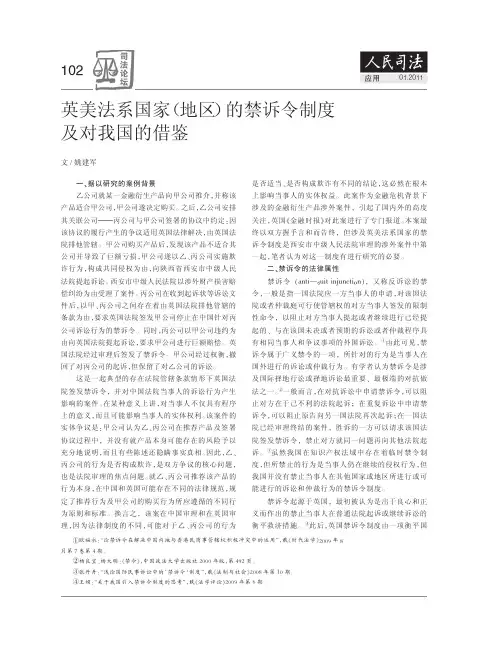
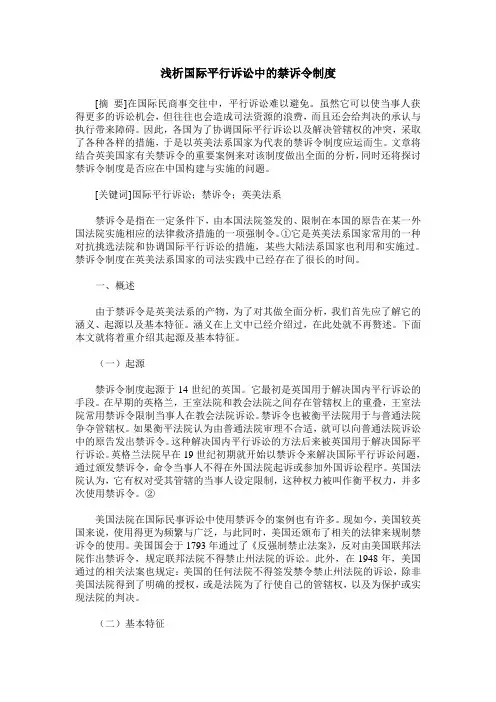
浅析国际平行诉讼中的禁诉令制度[摘要]在国际民商事交往中,平行诉讼难以避免。
虽然它可以使当事人获得更多的诉讼机会,但往往也会造成司法资源的浪费,而且还会给判决的承认与执行带来障碍。
因此,各国为了协调国际平行诉讼以及解决管辖权的冲突,采取了各种各样的措施,于是以英美法系国家为代表的禁诉令制度应运而生。
文章将结合英美国家有关禁诉令的重要案例来对该制度做出全面的分析,同时还将探讨禁诉令制度是否应在中国构建与实施的问题。
[关键词]国际平行诉讼;禁诉令;英美法系禁诉令是指在一定条件下,由本国法院签发的、限制在本国的原告在某一外国法院实施相应的法律救济措施的一项强制令。
①它是英美法系国家常用的一种对抗挑选法院和协调国际平行诉讼的措施,某些大陆法系国家也利用和实施过。
禁诉令制度在英美法系国家的司法实践中已经存在了很长的时间。
一、概述由于禁诉令是英美法系的产物,为了对其做全面分析,我们首先应了解它的涵义、起源以及基本特征。
涵义在上文中已经介绍过,在此处就不再赘述。
下面本文就将着重介绍其起源及基本特征。
(一)起源禁诉令制度起源于14世纪的英国。
它最初是英国用于解决国内平行诉讼的手段。
在早期的英格兰,王室法院和教会法院之间存在管辖权上的重叠,王室法院常用禁诉令限制当事人在教会法院诉讼。
禁诉令也被衡平法院用于与普通法院争夺管辖权。
如果衡平法院认为由普通法院审理不合适,就可以向普通法院诉讼中的原告发出禁诉令。
这种解决国内平行诉讼的方法后来被英国用于解决国际平行诉讼。
英格兰法院早在19世纪初期就开始以禁诉令来解决国际平行诉讼问题,通过颁发禁诉令,命令当事人不得在外国法院起诉或参加外国诉讼程序。
英国法院认为,它有权对受其管辖的当事人设定限制,这种权力被叫作衡平权力,并多次使用禁诉令。
②美国法院在国际民事诉讼中使用禁诉令的案例也有许多。
现如今,美国较英国来说,使用得更为频繁与广泛,与此同时,美国还颁布了相关的法律来规制禁诉令的使用。

第1篇一、引言美国是一个法治国家,其法律体系复杂而庞大。
在美国打官司,需要遵循一系列法律规定,包括但不限于证据规则、诉讼程序、法律文书等。
本文将从以下几个方面对美国打官司法律规定进行详细介绍。
二、证据规则1. 证据种类在美国打官司,证据种类繁多,主要包括以下几种:(1)口头证据:证人证言、当事人陈述等。
(2)书面证据:合同、文件、书信、录音、录像等。
(3)物证:实物、样品、照片等。
(4)鉴定意见:专家证人、鉴定机构出具的鉴定报告等。
2. 证据规则(1)证据真实性:证据必须真实、可靠,不得伪造、篡改。
(2)相关性:证据必须与案件事实有关联,有助于查明案件真相。
(3)合法性:证据获取方式必须合法,不得侵犯他人合法权益。
(4)充分性:证据应当充分,能够证明案件事实。
三、诉讼程序1. 诉讼阶段(1)起诉:原告向法院提交诉状,请求法院判决。
(2)答辩:被告在规定期限内提交答辩状,对原告的诉讼请求进行回应。
(3)证据交换:双方交换证据,为庭审做准备。
(4)庭审:法院开庭审理案件,双方陈述事实、提交证据、进行辩论。
(5)判决:法院根据庭审情况,作出判决。
2. 诉讼期限(1)起诉期限:一般要求在发生争议后一定期限内起诉。
(2)答辩期限:被告在收到起诉状后一定期限内提交答辩状。
(3)证据交换期限:法院规定一定期限内交换证据。
(4)庭审期限:法院根据案件复杂程度,确定庭审期限。
四、法律文书1. 诉状诉状是原告向法院提交的诉讼请求文件,应包括以下内容:(1)原告、被告的基本信息。
(2)案件事实和理由。
(3)诉讼请求。
2. 答辩状答辩状是被告向法院提交的回应原告诉讼请求的文件,应包括以下内容:(1)被告的基本信息。
(2)对原告诉讼请求的否认或承认。
(3)反驳原告的理由。
3. 证据清单证据清单是双方在庭审前交换证据的清单,应包括以下内容:(1)证据种类。
(2)证据来源。
(3)证据用途。
五、律师制度在美国打官司,律师是必不可少的角色。
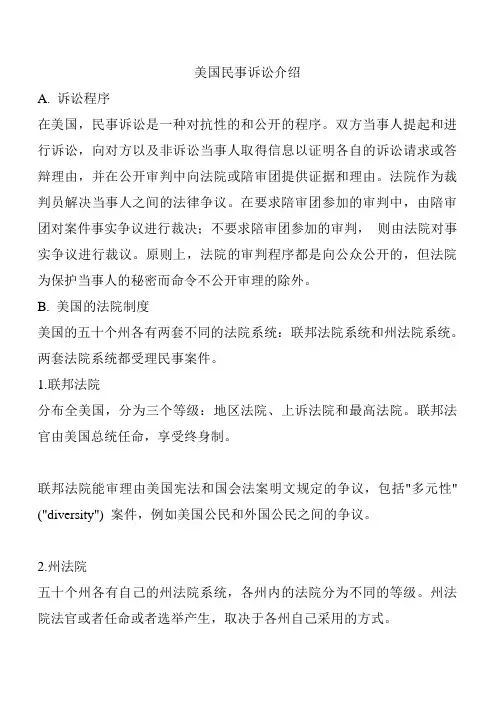
美国民事诉讼介绍A. 诉讼程序在美国,民事诉讼是一种对抗性的和公开的程序。
双方当事人提起和进行诉讼,向对方以及非诉讼当事人取得信息以证明各自的诉讼请求或答辩理由,并在公开审判中向法院或陪审团提供证据和理由。
法院作为裁判员解决当事人之间的法律争议。
在要求陪审团参加的审判中,由陪审团对案件事实争议进行裁决;不要求陪审团参加的审判,则由法院对事实争议进行裁议。
原则上,法院的审判程序都是向公众公开的,但法院为保护当事人的秘密而命令不公开审理的除外。
B. 美国的法院制度美国的五十个州各有两套不同的法院系统:联邦法院系统和州法院系统。
两套法院系统都受理民事案件。
1.联邦法院分布全美国,分为三个等级:地区法院、上诉法院和最高法院。
联邦法官由美国总统任命,享受终身制。
联邦法院能审理由美国宪法和国会法案明文规定的争议,包括"多元性" ("diversity") 案件,例如美国公民和外国公民之间的争议。
2.州法院五十个州各有自己的州法院系统,各州内的法院分为不同的等级。
州法院法官或者任命或者选举产生,取决于各州自己采用的方式。
州法院可以受理对当事人有属人管辖权的任何案件,除非联邦法院对争议事项拥有排他的管辖权。
联邦法院系统和州法院系统拥有各自的民事程序规则,包括了民事诉讼中的各种程序性问题。
大多数州的民事诉讼规则是以《联邦民事诉讼规则》(简称"《联邦规则》",) 为蓝本制定的。
本大纲即以联邦规则为依据。
3.哪些法院最有可能受理牵涉中国被告的争议?对中国被告提起的诉讼,一般既可以在州法院也可以在联邦法院起诉。
通常是由原告选择在哪个法院提起诉讼。
起诉可以选择在地方性的法院,通常是州法院。
在某些情沉下,中国被告可以将案件从州法院转移至联邦法院。
这是因为联邦法官通常被认为较之州法院法官更为公允,并且,联邦法院多位于大城市,从而陪审团成员可以从一个较大的和更广泛的社区背景之中选择出来。

美国的审判制度——美国司法制度简介之三发布时间:2008-12-02 15:33:20一、美国民事审判制度美国联邦法院审理民事案件实行三级二审终审制。
一般民事案件由联邦地区法院作为初审法院,当事人不服初审法院的判决,可以向联邦上诉法院提起上诉。
如对法院适用的法律有异议,可以向联邦最高法院提出司法审查的请求。
在美国法律中,民事案件是指公民、法人之间的索赔或者要求补救的纠纷。
民事诉讼往往是因一方当事人的违约行为或者不法行为或者民事侵权行为所引起的。
由于美国是一个成文法和判例法并存的普通法系国家,因此在民事审判制度中许多内容是由法院的判例所确认的,而不同于其它成文法国家,凭借一部完整的民事诉讼法,确认该国的民事审判制度。
从美国的联邦民事诉讼程序规则和民事判例看,其民事审判制度大致如下。
(一)起诉与受理如果公民或法人认为自己已经受到其它公民或法人的不法侵犯或损害,他就开始去聘请律师,并向律师陈述自己起诉的理由及有关情况。
在接受当事人的聘请之后,律师就开始着手调查,会见证人,查看有关法令或法院的判例,以决定当事人是否有理由起诉。
如果认为当事人起诉理由充分,且又有足够的法律依据,律师便决定起草起诉书。
起诉书必须列举出明确的被告人,提出充分的事实根据和法律根据。
律师必须选择适当的法院进行起诉,原告律师还必须向法庭书记官提出关于要求发出传票的命令状,请求法庭书记官发出传票,或通知、指示司法行政长官将起诉书副本送达被告人。
司法行政长官将传票送达被告人后,必须将传票的原本送返法院,并向法院说明送达传票的主要情况。
送达传票是向被告人发出的诉讼正式通知诉讼就从提交起诉书和送达传票开始。
法院受理案件的条件是,法院必须能够对被告人实行控制,或者与案件有关的财产必须坐落在该法院的管辖区域内。
也就是说,有些诉讼是采用属人原则,只要找到被告人并送达传票的任何州的任何地区都可以起诉。
例如,人身伤害案件,就是由被告人所在地法院受理。
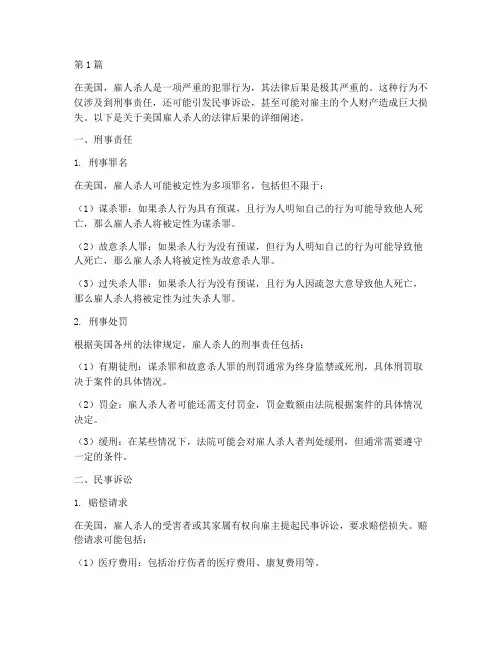
第1篇在美国,雇人杀人是一项严重的犯罪行为,其法律后果是极其严重的。
这种行为不仅涉及到刑事责任,还可能引发民事诉讼,甚至可能对雇主的个人财产造成巨大损失。
以下是关于美国雇人杀人的法律后果的详细阐述。
一、刑事责任1. 刑事罪名在美国,雇人杀人可能被定性为多项罪名,包括但不限于:(1)谋杀罪:如果杀人行为具有预谋,且行为人明知自己的行为可能导致他人死亡,那么雇人杀人将被定性为谋杀罪。
(2)故意杀人罪:如果杀人行为没有预谋,但行为人明知自己的行为可能导致他人死亡,那么雇人杀人将被定性为故意杀人罪。
(3)过失杀人罪:如果杀人行为没有预谋,且行为人因疏忽大意导致他人死亡,那么雇人杀人将被定性为过失杀人罪。
2. 刑事处罚根据美国各州的法律规定,雇人杀人的刑事责任包括:(1)有期徒刑:谋杀罪和故意杀人罪的刑罚通常为终身监禁或死刑,具体刑罚取决于案件的具体情况。
(2)罚金:雇人杀人者可能还需支付罚金,罚金数额由法院根据案件的具体情况决定。
(3)缓刑:在某些情况下,法院可能会对雇人杀人者判处缓刑,但通常需要遵守一定的条件。
二、民事诉讼1. 赔偿请求在美国,雇人杀人的受害者或其家属有权向雇主提起民事诉讼,要求赔偿损失。
赔偿请求可能包括:(1)医疗费用:包括治疗伤者的医疗费用、康复费用等。
(2)经济损失:包括受害者因受伤或死亡而导致的收入损失、财产损失等。
(3)精神损害赔偿:包括受害者及其家属因雇人杀人行为所遭受的精神痛苦、心理创伤等。
2. 民事诉讼结果在美国,民事诉讼的结果取决于法院的判决。
如果法院判决雇主败诉,雇主需支付相应的赔偿金。
赔偿金的数额由法院根据案件的具体情况决定。
三、其他法律后果1. 职业资格受限在美国,雇人杀人者可能会被吊销或限制其职业资格,如医生、律师、教师等。
2. 社会信誉受损雇人杀人者及其家属的社会信誉可能会受到严重影响,这在一定程度上会影响到他们的日常生活。
3. 个人财产损失在美国,雇人杀人者可能需要承担刑事责任和民事诉讼的赔偿责任,这可能导致其个人财产损失。
试论英美法中的禁诉令制度禁诉令是英美法国家解决国际管辖权冲突的一种特殊制度,主要是针对本国法院具有属人管辖权的当事人,禁止其在外国法院诉讼的命令。
禁诉令可以用来解决平行诉讼的问题,防御其他国家的过渡管辖权,同时对本国司法主权和管辖权起到保护的作用。
大陆法国家对于禁诉令是比较陌生的,对禁诉令制度的研究也比较落后。
近年来,中国面对禁诉令的送达问题,逐渐引起理论界的关注,但是对于禁诉令有关问题的研究仍处于起步阶段。
鉴于上述情况,本文认为,加强禁诉令应对和适用的研究具有重要的现实意义和理论意义。
本文主要对英国和美国的禁诉令制度以及禁诉令在中国的应对和适用进行了论述。
全文分为四章,主要用分析比较的方法和实证分析的方法探讨了英国和美国作出禁诉令的原则、条件、标准等问题,研究了欧盟对于英国禁诉令的态度,以及美国各州对于禁诉令的承认方式,重点分析了中国禁诉令的案例和相关问题,结合中国学者的不同观点,针对我国应对和适用禁诉令提出建议。
第一章是禁诉令制度概述部分,主要介绍禁诉令的概念和特点、禁诉令的历史起源和发展等问题,为第二章、第三章对于英国和美国禁诉令制度的介绍打下基础。
第二章是英国的禁诉令制度,主要研究英国作出禁诉令的具体原则、类型,作出禁诉令的不同条件,欧盟对于英国禁诉令的应对态度,以及英国禁诉令的发展趋势等。
第三章是美国的禁诉令制度,主要研究美国作出禁诉令的条件和标准,比较英国和美国禁诉令的相关制度,以及美国各州对于禁诉令的承认方式等。
第四章是禁诉令在中国的有关问题,主要分析中国的禁诉令案件,对于其中的主要问题进行了研究,探讨禁诉令在送达问题以及送达中的公共秩序问题,比较分析我国学者对于禁诉令的不同观点,进而就我国如何应对和适用禁诉令提出了相关建议。
禁止令的司法适用研究随着社会的不断进步和发展,禁止令成为了司法适用中不可或缺的一部分。
禁止令是指在特定情况下,通过司法手段对某些行为的限制或禁止。
禁止令的司法适用在维护社会的稳定和公正,保护公民的利益方面具有重要的作用。
下面,我们将介绍三个禁止令在司法适用中的不同案例。
案例一:限制使用有毒物质在1991年,美国地方法院对约翰逊-约翰逊公司下达了禁止令,限制该公司在美国继续使用PBCs等有毒物质的生产和销售。
禁止令的颁布,一方面保护了公民的健康和安全,另一方面也促进了环境的保护,成为全球关注的热点问题。
案例二:避免侵犯他人财产权在2017年,中国人民法院根据告知,判决崔机武等人称名下的财产被认定为干扰国家调查的违法所得,封存并加以保护。
这是一项禁止令,旨在避免侵犯他人财产权,维护公平正义。
案例三:限制潜逃出境在2014年,曾是浙江省宁波市一位企业老板的丁某被判违法36年,但是他却潜逃出境,丧失了处理法律纠纷的能力。
在此后的岁月里,丁某一直被限制出境,成为禁止令的实施对象。
这个案例表明,禁止令也被用于限制潜逃出境,保护社会公平和公正。
总之,禁止令在司法适用中具有广泛的应用,是维护公民权益、促进社会治理的重要手段。
通过禁止令的运用,我们可以保证公民的安全和财产权益,确保社会的公平和正义。
因此,禁止令的执行应得到法律、法规和相关机构的支持和鼓励,为社会稳定和长远发展保驾护航。
除了以上三个案例之外,禁止令在司法实践中还有许多应用场景,如限制恶意诉讼、禁止离婚抚养争议期间父母将子女带出境等。
这些案例表明,禁止令不仅仅是在保护公民权益和社会公正方面发挥作用,在保护社会安全和稳定等方面也有重要的作用。
在执行禁止令的过程中,司法机关应当遵循法律程序,确保法律的公正、透明和可信度,防止滥用或不当的行为,保障当事人的合法权益。
而在被强制执行禁止令的当事人方面,应当严格遵守禁止令规定,不得再次违背禁止令的规定,否则将面临更严重的法律后果。
英美国际私法中禁诉令制度的比较作者:罗极来源:《科教导刊·电子版》2014年第11期摘要禁诉令是英美法系国家和地区一项历史悠久且极具特色的法律制度,在英美等国的民事诉讼理论及实践中占据重要地位。
随着国际民商事往来日益频繁,我国的当事人在参与国际民商事诉讼的过程中,也开始遭遇或利用禁诉令这一制度。
这使得我们必须对禁诉令制度加以重视和研究,并有必要逐步将该制度引入到我国的法律规范中,作为解决我国区际以及国际管辖权冲突的一种手段,以在国际民事诉讼程序中更好的保护我国当事人的合法权益。
关键词国际民商事诉讼平行诉讼禁诉令国际管辖权中图分类号:D997.3 文献标识码:A在国际民事诉讼中,平行诉讼是指相同当事人就同一争议基于相同事实以及相同目的同时在两个或两个以上国家的法院进行诉讼的现象,是各国管辖解决极冲突的一种表现。
导致国际平行诉讼的原因有很多,而国际平行诉讼所造成的消极影响也是显而易见的。
目前在实践当中解决国际平行诉讼的方法有不方便法院、禁诉令以及未决诉讼等。
其中,禁诉令是法院采取的最积极的同时也是最饱受争议的一项制度。
1禁诉令制度的概述1.1概念禁诉令制度起源于英国,最初是作为一种解决国内平行诉讼的手段出现的。
禁诉令又称为禁诉命令或反诉命令,是指法院为终止在外国法院进行的诉讼而签发的命令,此类命令指示受到法院属人管辖的一方当事人不得在外国法院起诉或参加预期的或未决的外国诉讼。
1.2特征禁诉令主要有以下几个方面的特征:第一,禁诉令是法院向其具有管辖权的当事人作出的。
第二,禁诉令产生效力的对象是诉讼当事人,而不是外国法院。
禁诉令并不是针对外国法院,要求外国法院停止管辖,而是仅仅约束对人诉讼的当事人。
第三,禁诉令是为了禁止当事人在外国法院进行诉讼。
第四,禁诉令具有一定的惩罚性。
如果当事人不遵守禁令,继续进行在外国的诉讼,就会被法院视为藐视法庭,当事人通常会受到制裁甚至被罚款或入狱,或者公司资产将被查封。
国际民事诉讼中的禁诉令制度研究禁诉令是英美法系国家和地区一项历史悠久且极具特色的法律制度,在英美等国的民事诉讼理论及实践中占据重要地位。
其起源于英国,是衡平法院和普通法院相抗衡的产物,后逐步从解决国内民事管辖权冲突运用到国际民事诉讼程序中,成为解决国际平行诉讼的一种有效手段。
禁诉令的签发需要满足一些基本的原则和条件:(1)法院只能对其拥有属人管辖权的当事人签发禁诉令;(2)在外国法院和本国法院同时进行的平行诉讼中当事人及系争点相同;(3)有必要通过签发禁诉令保护本国的重要公共政策。
在满足基本条件之后,法院还必须考虑国际礼让原则,因为禁诉令尽管从性质上来说是针对当事人签发的,仅仅是对当事人在外国起诉行为的正当性进行评价,但其在效果上却间接的干涉到了外国法院的司法管辖权,因此法院在签发禁诉令时必须保持谨慎的态度。
而禁诉令违背国际礼让原则以及存在干涉他国司法主权的可能性的特点,也是该制度在英美法系国家和地区之外被否定和批评的一个重要原因。
随着全球经济一体化的加快发展,国际民商事往来日益频繁,中国在加入WTO后,中方当事人越来越多的参与到了国际贸易中去,由此遇到的国际民商事争议也日益增多,我国的当事人在参与国际民商事诉讼的过程中,也开始遭遇或利用禁诉令这一制度,这使得我们必须对禁诉令制度加以重视和研究,并有必要逐步将该制度引入到我国的法律规范中,作为解决我国区际以及国际管辖权冲突的一种手段,以在国际民事诉讼程序中更好的保护我国当事人的合法权益。
本文拟从四个方面探讨国际民事诉讼中的禁诉令制度。
第一部分主要介绍禁诉令制度的历史起源、概念及性质,其中对禁诉令制度最受争议的地方,即禁诉令违反了国际礼让原则这一问题作进一步的论述。
第二部分及第三部分主要采用实证分析和比较分析的方法,结合有关禁诉令的典型案例,分别对英国和美国的禁诉令制度进行详细介绍和分析,除对英美两国签发禁诉令的原则、条件、具体情况等进行介绍外,还将讨论《布鲁塞尔公约》对英国法院签发禁诉令的权力的影响,以及美国巡回法院在禁诉令问题上形成的三种不同标准。
论国际诉讼管辖权冲突中的禁诉令制度作者:赵威来源:《理论探索》2021年第04期〔摘要〕行业标准的制定在全球高新技术产业发展中发挥着积极作用,但同时也可能成为标准必要专利权人实施垄断行为的手段。
目前,全球范围内移动通信领域纠纷频发,生产商通过专利侵权诉讼、申请禁诉令、禁令救济等手段争夺市场份额。
禁诉令旨在排除他国司法管辖权,防止国家间管辖权冲突。
在美国对我国企业实施更多制裁的背景下,禁诉令制度有利于我国制衡美国的长臂管辖,确保我国法院能够依法规制滥用专利权阻碍竞争的企业,从而保护我国企业的合法权益。
通过对微软诉摩托罗拉等案例的分析,探寻禁诉令制度在标准必要专利诉讼中的应用以及各国法院的实践情况,可以得出禁诉令制度在全球发展的趋势,即禁诉令制度在标准必要专利纠纷中扩张适用,禁诉令颁布的不确定性加大,管辖权的扩张,这为我国相关制度的完善提供了经验借鉴。
〔关键词〕管辖权冲突,禁诉令制度,标准必要专利〔中图分类号〕D91 〔文献标识码〕A 〔文章编号〕1004-4175(2021)04-0117-06在高新技術产业,标准必要专利在实现产品兼容性和互操作性、促进技术进步等方面都发挥着不可或缺的作用。
但另一方面,标准也可能成为标准必要专利权人制造进入壁垒、进行专利伏击、排除其他市场竞争者的手段。
一旦经营者针对某一标准进行相关基础投资,则受高额转换成本的影响,就被锁定在了标准之上,使得标准中的每项专利对于经营者而言都至关重要,从而为标准必要专利权人滥用专利权提供了可乘之机。
目前,移动通信领域的争议和纠纷在全球范围内激增,某些国家也开始采取相关贸易措施维护本国企业利益,妨碍国际市场上的自由竞争关系。
例如自2010年起,美国商务部就进一步加强了出口管控政策,限制华为获取美国技术的渠道,同时针对以华为为代表的中国企业采取了如歧视性收费、加大禁令等制裁措施。
完善禁诉令制度则是我国针对美国的制裁采取有效反制措施的基础,在确保我国法院依法行使管辖权的同时,也保障了我国判决在他国的承认和执行。
《美国联邦地区法院民事诉讼规则》简称《美国联邦民事诉讼规则》目录美国联邦民事诉讼规则导论美国联邦民事诉讼规则第1章本规则的适用范围和一种诉讼形式第1条本规则的适用范围和目的第2条一种诉讼形式第2章诉讼开始;传唤令状、诉答文书、申请书及命令的送达第3条诉讼开始第4条传唤状第4条之1其他令状的送达第5条诉答文书和其他文件的送达与提交第6条期间第3章诉答文书和申请书第7条允许提出的诉答文书;申请书的格式第8条诉答文书的一般规则第9条诉答文书的特别事项第10条诉答文书的格式第11条诉答文书、申请书及其他文件的签名;向法院的陈述;制裁第12条抗辩和异议——提出的期间和方式——通过诉答文书或申请书——基于诉答文书请求判决的申请第13条反请求和交叉请求第14条第三当事人诉讼程序第15条修改和补充诉答文书第16条审理前会议;日程;管理第4章当事人第17条原告和被告;当事人能力第18条请求和救济方法的合并第19条为公正审判而必要合并的人第20条当事人的许可合并第21条当事人的合并错误及不合并第22条互争权利诉讼第23条集团诉讼第23条之1股东的派生诉讼第23条之2关于非法人团体的诉讼第24条诉讼参加第25条替代当事人第5章庭外证言与发现程序第26条规范发现程序的一般规定;出示义务第27条诉讼之前和上诉系属期间的庭外证言第28条参与作成庭外证言的人员第29条关于发现程序的约定第30条口头询问的庭外证言第31条书面质问的庭外证言第32条在法院的诉讼程序中庭外证言的使用第33条对当事人的质问书第34条提供文件和物件以及为调查或其他目的而进入房地产第35条身体和精神状态的检查第36条要求自认第37条不出示或不协助发现:制裁第6章开庭审理第38条要求陪审团审判的权利第39条陪审团审判或法院审判第40条为开庭审理而分配案件第41条撤销诉讼第42条合并;分开审理第43条证言的取得第44条官方记录证明第44条之1外国法的确定第45条传票第46条不需要提出异议第47条选定陪审团成员第48条陪审团成员人数——参与裁决第49条特别裁决和质问书第50条在陪审团审判的案件中作为法律问题作出的判决;选择重新审理的申请;有条件的裁定第51条对陪审团的指示:异议第52条法院认定事实;部分认定事实的判决第53条主事官第7章判决第54条判决;费用第55条缺席第56条简易判决第57条宣告判决第58条登记判决第59条重新审理;判决的修改第60条对判决或命令的救济第61条无害的错误第62条执行判决程序的中止第63条法官不能继续执行职务第8章临时性和终局性财产救济方法第64条对人或财产的扣押第65条禁止令第65条之1担保:对保证人的诉讼程序第66条被联邦法院任命的财产管理人第67条向法院提存第68条判决方案要约第69条执行第70条特定行为的判决;赋予权限第71条有利于或不利于非当事人的第三人的令状第9章特别程序第71条之1不动产征收第72条补助法官;审理前命令第73条补助法官;同意审判及上诉的选择权第74条根据《美国法典》第28编第636条第3款(4)项和本规则第73条第4 款的规定,对补助法官作出的决定向地区法院法官提起上诉的方式第75条根据本规则第73条第4款的规定,对补助法官作出的决定向地区法院法官提起上诉的程序第76条根据本规则第73条第4款的规定向地区法院法官提起上诉案件的判决和诉讼费用第10章地区法院及其书记官第77条地区法院及其书记官第78条申请期日第79条书记官保管的登记簿和记录以及登记第80条速记员;用作证据的速记员报告及速记译回文字第11章一般条款第81条一般适用性第82条管辖区域及审判地不受影响第83条地区法院的规则;法官的指令第84条诉讼文书格式第85条本规则的称谓第86条生效日期附件一:诉讼文书格式附件二:《美国联邦民事诉讼规则》中的词汇英中文语义对照表美国联邦证据规则导言《美国联邦证据规则》介绍第101条适用范围第102条目的和结构第103条关于证据的裁定(a)错误裁定的后果(1)异议(2)提供证明(b)关于提供证据和裁定的记录(c)陪审团审理(d)显见错误第104条初步询问(a)关于可采性的一般询问(b)以事实为条件的相关性(c)陪审团审理(d)被告人作证(e)重要性和可信性第105条有限的可采性第106条书面或录音证词的剩余部分或相关部分第2章司法认知第201条关于裁判事实的司法认知(a)适用范围(b)事实种类(c)任意采用(d)强制采用(e)被听证的机会(f)采用司法认知的时间(g)指示陪审团第3章民事诉讼中的推定第301条民事诉讼中推定的一般规定第302条民事诉讼中州法的适用性第4章相关性及其限制第401条“相关证据”的定义第402条相关证据一般可以采纳;无相关性的证据不能采纳第403条因偏见、混淆或浪费时间而排除相关证据第404条品格证据不能采纳来证明行为;例外;其他犯罪(a)品格证据的一般规定(1)被告人的品格(2)被害人的品格(3)证人的品格(b)其他犯罪、错误或行为第405条证明品格的方法(a)名声或评价(b)特定行为实例第406条习惯;日常工作第407条随后的补救措施第408条和解和要求和解第409条支付医疗或类似费用第410条答辩、答辩讨论和有关陈述不可采纳第411条责任保险第412条性犯罪案件;与被害人过去行为相关第5章特权第6章证人第601条关于证人能力的一般规则第602条缺乏亲身体验第603条宣誓或郑重声明第604条译员第605条法官作为证人的能力第606条陪审员作为证人的能力(a)参加审理(b)对陪审团裁决或起诉书合法性的调查第607条谁可以提出质疑第608条关于证人品格和行为的证据(a)关于品格的评价证据和名声证据(b)行为的具体实例第609条以曾被定罪的证据提出质疑(a)一般规则(b)时间限制(c)赦免、撤销或证明恢复名誉的效果(d)未成年人的裁判(e)上诉未决第610条宗教信仰或主张第611条询问和举证的方式和次序(a)法庭控制(b)交叉询问的范围(c)诱导性问题第612条使用书面材料来唤醒记忆第613条证人先前的陈述(a)就证人先前的陈述进行询问(b)有关证人先前陈述不一致的外部证据第614条法庭传唤和询问证人(a)法庭传唤证人(b)法庭询问(c)异议第615条排除证人第7章意见证据和专家证词第701条一般证人的意见证词第702条专家证词第703条专家意见证词的基础第704条关于最终争议的意见第705条公开专家意见所依据的事实和数据第706条法庭指定专家(a)指定(b)补偿(c)将指定公开(d)当事人自己选择专家第8章传闻证据第801条定义(a)陈述(b)陈述者(c)传闻(d)不是传闻的陈述(1)证人的先前陈述(2)为对立当事人承认第802条传闻证据规则第803条传闻证据的例外;陈述者可否作证无关紧要(1)表达感觉印象(2)刺激的发泄(3)当时存在的精神、感情或身体状态(4)出于医疗诊断或治疗目的的陈述(5)被记录的回忆(6)关于日常行为、活动的记录(7)在第(6)项规定的记录中缺乏记载(8)公共记录或报告(9)重要统计资料(10)缺乏公共记录或没有记载(11)宗教组织的记录(12)婚姻、洗礼或类似证明(13)家庭记录(14)反映财产利益的文件记录(15)文件中反映财产利益的陈述(16)在陈年文件中的陈述(17)市场报告商业出版物(18)学术论文(19)关于个人或家庭历史的名声(20)关于边界和一般历史的名声(21)性格方面的名声(22)先前定罪的判决(23)关于个人、家庭、或一般历史、或边界的判决(24)其他例外第804条传闻证据的例外;陈述者不能到庭作证(a)不能出庭的定义(b)传闻证据的例外(1)先前证词(2)临终陈述(3)对己不利的陈述(4)关于个人或家史的陈述(5)其他例外第805条传闻中的传闻…第806条攻击和支持陈述者的可信性第9章鉴定和辨认第901条要求鉴定或辨认(a)一般规定(b)说明(1)具有知识的人的证明(2)对笔迹的非专家意见(3)由审判者或专家证人进行比较(4)与众不同的特征或类似品质(5)声音辨认(6)声音通话(7)公共记录或报告(8)陈年文件或数据汇编(9)过程或系统(10)法律或规则规定的方法第902条自我鉴定(1)国内盖有印章的公文(2)国内未盖印章的公文(3)外国公文(4)经证实的公共记录的副本(5)官方出版物(6)报纸和期刊(7)商品注册或类似标记(8)被承认的文件(9)商业票据和相关文件(10)根据国会立法推定第903条不必要有补强证人证词第10章文字、录音和照相的内容第1001条定义(1)文字和录音(2)照相(3)原件(4)复制品第1002条要求原件第1003条复制品的可采性第1004条其他关于内容的证据的可采性(1)原件遗失或毁坏(2)原件无法获得(3)原件在对方掌握中(4)附属事项第1005条公共记录第1006条摘要第1007条当事人的证词或书面承认第1008条法庭和陪审团的职能第11章综合规则第1101条规则的适用性(a)法院和治安法院(b)诉讼范围(c)关于特权的规则(d)不适用规则的情况(e)部分适用的规则第1102条修改第1103条标题。
美国民事诉讼中的三种禁止令
链接
LINK
“尽管美国法律的复杂性让人畏惧,但是美国民事诉讼中的很多程序性规定却完全可以被企业拿来使用,以最大限度地保护企业利益不受或少受损害,联邦法院体系下的三种禁止令就是典型。
”霍金路伟国际律师事务所上海办事处顾问律师陈道正告诉《中国经营报》记者。
需要说明的是,禁止对象如果违反这三种禁令,将被法院判处极高的罚金,因而禁令的执行效率是很高的。
“临时禁止令”
“临时禁止令”(Temporary Order,即TOR)是企业在非常紧急的情况下申请的一种保障措施。
它在做出前不需要通知对方,只需要申请方提供证据证明如果不采取该种保护措施,企业将受到不可逆转的损失和打击,而这种损失和打击是不可能通过赔偿就挽回的。
比如一座有纪念意义的房子就要被卖掉,权利方就可以申请法院及时禁止这一交易。
通常来说,法院会在极短的时间内做出决定。
在华为案中,从企业申请到法院做出决定,中间只有一天的时间。
不过,“临时禁止令”只有14天的有效期,它设立的目的是为当事人争取到时间,随后当事人(企业)就必须进行诉讼或申请“初步禁止令”(Paramilitary Injunction),以获得更长时间的保护。
同时,申请“临时禁止令”需要支付相关担保费用。
法官会对此做出权衡,提出一个数字,而法官考虑的因素就是如果不阻止某项交易,当事人受到的损失以及当事人如果败诉该禁止令可能会给被告造成的损害。
在华为案中,华为阻止的是两大跨国公司摩托罗拉与诺西的并购交易,担保金额应该较大。
即使如此,企业也不用担心,因为在美国有专门帮助企业提供此类担保的公司,申请企业只需支付较少的费用即可。
只是,申请到禁止令的企业接下来必须进行诉讼,否则担保费就会被没收。
“初步禁止令”
“初步禁止令”(Paramilitary Injunction),它的申请在时间上没有“临时禁止令”要求的那么紧急,初步禁止令在颁发前需要通知对方,并且有一个双方讨价还价的过程。
按照美国的判例法,申请“初步禁止令”的企业需要满足四个条件:一是申请人要向法院解释在实质性问题的诉讼中它有很大可能取得成功,法院也会依据这部分事实并做出判断;二是申请人要证明如果没得到这个判令,所受损失即使胜诉也很难修正;三是申请人要向法院说明,即法院做出这个判令与不做出这个判令哪个风险或损失更大一些;四是判令要涉及公共利益的考虑,律师必须对此做出评价。
从实践上来看,“初步禁止令”(Paramilitary Injunction)因为能有效阻挡对手的交易,因而有些企业申请到禁令就停止了,当然申请人如果想把它作为一个最终的判决(FINAL)来看的话,还需要在诉讼中提出要求。
“永久性禁止令”
“永久性禁止令”(Permanent Injunction)往往在特殊诉讼中才会出现,作为判决的一部分,是对案件救济的一种方式。
本版文章均由本报记者屈丽丽撰写。